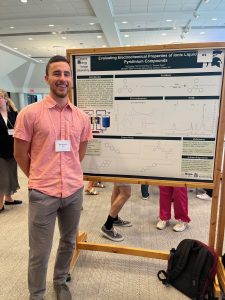Evaluating ionic liquid pyridinium compounds for non-aqueous redox flow batteries
Ed Zornow, Dennis Downing and Dr. Thomas Guarr
The energy capabilities of aqueous Redox Flow Batteries (RFBs) are limited by the use of water as a solvent which has a narrow potential window, resulting in relatively low energy density. In addition, many redox-active compounds of interest are not highly soluble in aqueous electrolytes. Using non-aqueous electrolytes in RFBs can circumvent these issues. Ionic liquids are organic salts that are in the liquid state at room temperature and exhibit attractive electrolyte properties such as wide potential windows, and high conductivity. Furthermore, by using a redox-active compound as the basis, solubility is maximized since there is no additional solvent or electrolyte salt. Functionalizing pyridinium compounds with hydrocarbon or oligoether chains to form ionic liquid derivatives has the potential to provide effective and recyclable electron carriers for non-aqueous redox-flow batteries. Several pyridinium compounds of various functionalizing groups with hydrocarbons were synthesized and characterized via NMR, mass spectrometry, and cyclic voltammetry.
Ed graduated in the spring with a Chemistry degree from Notre Dame. He spent the summer synthesizing pyridinium compounds in our lab. Ed is a great guy and we are waiting to hear what his future holds.



